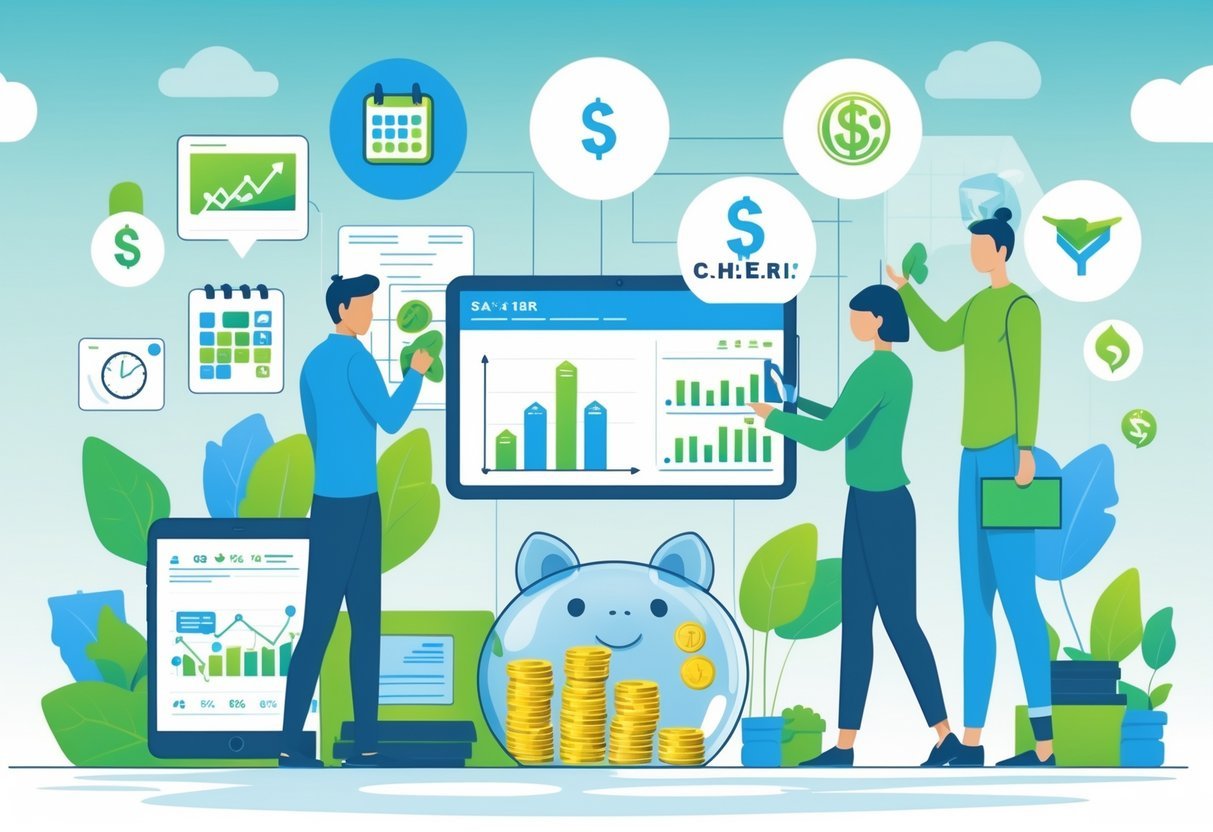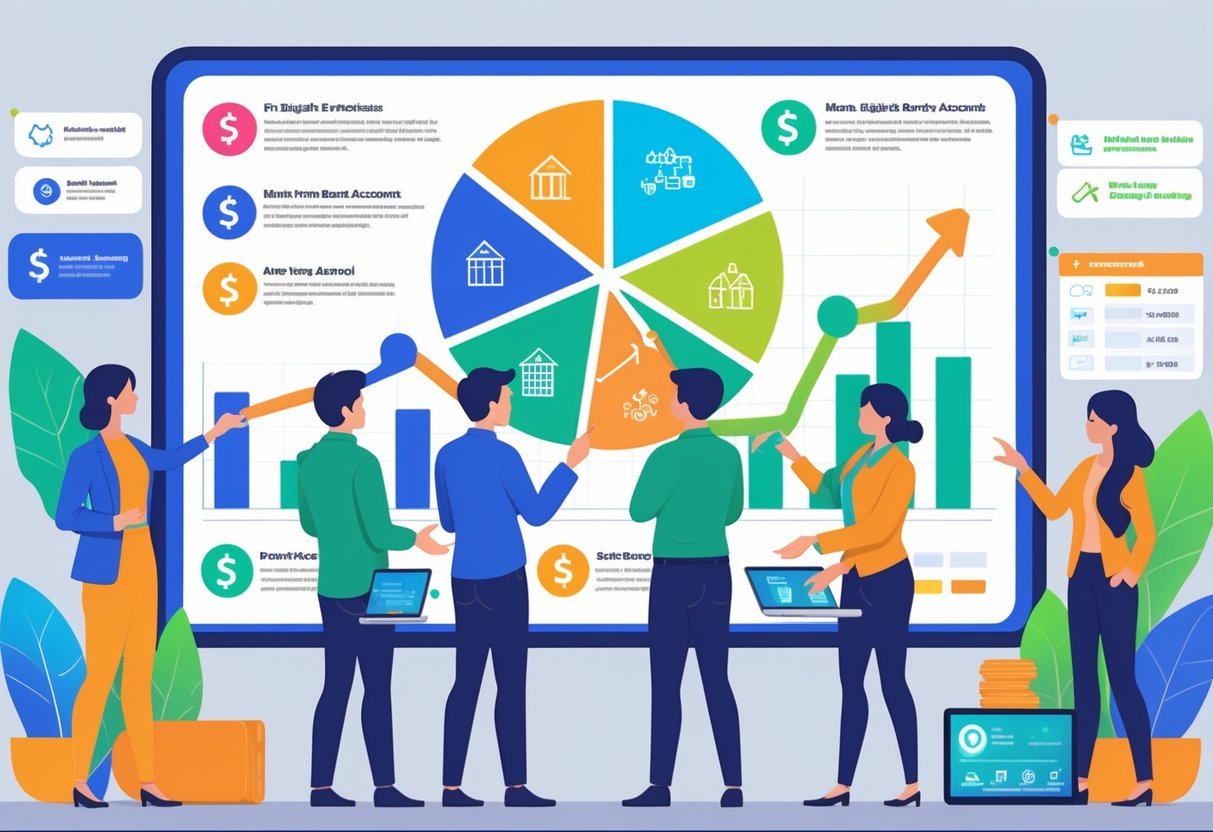Managing your paycheck wisely can help you build wealth over time. The C.H.E.R.I method offers a structured approach to handling your money when you get paid. This strategy helps you prioritize savings, retirement, and investments to maximize your financial growth while maintaining financial security.
C.H.E.R.I stands for Cash reserves, High-yield savings, Employee accounts, Retirement accounts, and Investment accounts. Starting with cash reserves ensures you have emergency funds, then moving to high-yield savings accounts at institutions like Ally Bank or Marcus by Goldman Sachs. Next, contribute to employer-sponsored plans through companies like Fidelity or Vanguard, followed by retirement accounts such as Roth IRAs through Charles Schwab. Finally, consider individual brokerage accounts with platforms like TD Ameritrade.
Key Takeaways
- The C.H.E.R.I method provides a systematic approach to allocating your paycheck across different financial priorities.
- High-yield savings accounts and employer-sponsored retirement plans form the foundation of financial security and long-term growth.
- Individual and taxable brokerage accounts offer flexibility for investments beyond retirement once other financial priorities are addressed.
Understanding the C.H.E.R.I Method
The C.H.E.R.I Method provides a structured approach to managing your money effectively when you receive your paycheck. This framework helps you prioritize financial goals and build wealth over time.
Overview of the C.H.E.R.I Framework
C.H.E.R.I stands for Costs, High-yield savings, Employee benefits, Retirement accounts, and Investment accounts. This framework creates a systematic order for allocating your paycheck.
C – Costs: Cover essential living expenses first, including rent/mortgage, utilities, groceries, and minimum debt payments. These represent your non-negotiable financial obligations.
H – High-yield savings: Direct money to high-yield savings accounts (HYSAs) for emergency funds and short-term goals. Companies like Ally Bank, Marcus by Goldman Sachs, and Capital One offer competitive rates.
E – Employee benefits: Maximize employer-sponsored benefits like 401(k) matches, HSAs, or FSAs. Providers include Fidelity, Vanguard, and Principal.
How the C.H.E.R.I Method Helps Manage Your Paycheck
The C.H.E.R.I Method creates a clear priority system that ensures all financial needs are addressed. By following this order, individuals avoid neglecting important financial areas.
The method encourages automation of savings and investments. Setting up automatic transfers on payday helps maintain discipline and consistency.
This framework balances short-term needs with long-term growth. It ensures immediate expenses are covered while still building wealth for the future.
The method also maximizes potential employer matches and tax advantages. This leads to significant financial benefits that might otherwise be missed.
Many people who use this method report reduced financial stress. Having a clear plan for each dollar of income provides peace of mind.
Steps to Implement the C.H.E.R.I Method
- Calculate essential costs: Determine your non-negotiable monthly expenses and ensure they’re covered first.
- Set up automatic transfers to a HYSA for emergency funds (3-6 months of expenses) and short-term goals.
- Review employee benefits and contribute enough to get full employer matches. Companies like Empower and T. Rowe Price administer many employer plans.
- Open retirement accounts if not available through work. Vanguard, Schwab, and Fidelity offer Roth and Traditional IRAs.
- Establish investment accounts for additional wealth building. Betterment, Wealthfront, and M1 Finance provide taxable brokerage accounts (TBAs).
Establishing Savings with High-Yield Savings Accounts

High-yield savings accounts offer significantly better interest rates than traditional savings accounts, helping your money grow faster while remaining accessible for emergencies.
Benefits of High-Yield Savings Accounts
High-yield savings accounts typically offer interest rates 10-25 times higher than traditional bank savings accounts. This difference can significantly impact your savings growth over time. For example, $10,000 in a traditional account at 0.01% APY earns just $1 annually, while the same amount in a HYSA at 4.00% APY generates $400.
These accounts provide FDIC insurance protection of up to $250,000 per depositor, ensuring your money remains safe. Most HYSAs have no monthly maintenance fees and low or no minimum balance requirements.
HYSAs also offer liquidity, allowing you to access your funds when needed, unlike certificates of deposit that penalize early withdrawals. This makes them ideal for emergency funds and short-term savings goals.
Best Companies Offering HYSA (Ally, Marcus by Goldman Sachs, American Express National Bank)
Ally Bank (ally.com) offers competitive rates currently around 4.00% APY with no minimum deposit and no monthly fees. Their user-friendly mobile app makes managing your money simple.
Marcus by Goldman Sachs (marcus.com) provides rates near 4.00% APY with no fees and no minimum deposits. They’re known for excellent customer service and a straightforward digital experience.
American Express National Bank (americanexpress.com/banking) offers HYSAs with competitive rates around 3.90% APY, no fees, and no minimums. Account holders can link existing American Express cards for seamless transfers.
Other strong options include Capital One 360, Discover Bank, and Synchrony Bank, all offering similar benefits with slight variations in rates and features.
Automating Contributions to Your HYSA
Setting up automatic transfers to your HYSA ensures consistent saving without requiring constant attention. Most banks allow you to schedule recurring transfers from checking to savings accounts on paydays.
Consider the 50/30/20 rule for budgeting: 50% for needs, 30% for wants, and 20% for savings. Using this guideline, set up automatic transfers of 20% of your income to your HYSA.
Many employers offer direct deposit splitting, allowing portions of your paycheck to go directly into different accounts. This “pay yourself first” approach ensures savings happen before spending.
Review and adjust your automatic contributions quarterly as your income or expenses change. Gradually increase your savings rate as your financial situation improves.
Maximizing Employee Sponsored Accounts

Employee sponsored accounts offer powerful tax advantages and free money through employer matching programs. Taking full advantage of these benefits can significantly boost your retirement savings with minimal effort.
Types of Employee Sponsored Accounts
401(k) plans are the most common employee retirement accounts, allowing you to contribute pre-tax dollars that grow tax-deferred until retirement. In 2025, you can contribute up to $23,000 annually, with an additional $7,500 catch-up contribution if you’re over 50.
403(b) plans work similarly to 401(k)s but are offered by nonprofit organizations, schools, and healthcare companies. They follow the same contribution limits as 401(k) plans.
457 plans are available to state and local government employees. The unique advantage here is that you can contribute to both a 457 plan and a 401(k)/403(b) simultaneously, effectively doubling your tax-advantaged saving capacity.
SIMPLE IRAs are typically offered by small businesses with fewer than 100 employees. They have lower contribution limits ($16,000 in 2025) but simpler administration requirements.
Top Providers for Employee Accounts (Fidelity, Vanguard, Charles Schwab)
Fidelity Investments (fidelity.com) offers comprehensive 401(k) services with low-cost index funds, zero-fee options, and user-friendly mobile apps. Their customer service consistently ranks highly in industry surveys.
Vanguard (vanguard.com) stands out for its low-cost index funds and ETFs. Their employee plans provide excellent educational resources and retirement planning tools to help employees make informed decisions.
Charles Schwab (schwab.com) combines competitive fees with a wide selection of investment options. Their 401(k) plans include helpful features like automatic rebalancing and personalized retirement calculators.
All three providers offer:
- $0 account maintenance fees
- Mobile app access
- Retirement planning tools
- Educational resources
Optimizing Employer Contributions and Matching
Always contribute at least enough to get your full employer match. This is literally free money – an immediate 50% to 100% return on your investment, depending on your employer’s matching formula.
Some employers use vesting schedules that determine when company contributions fully belong to you. Understand your vesting schedule to avoid leaving money behind if you change jobs.
Consider using automatic contribution increases of 1-2% annually to painlessly boost your savings rate. Many plans offer this feature, allowing you to align increases with annual raises.
For maximum tax efficiency, evaluate whether traditional pre-tax contributions or Roth contributions make more sense based on your current tax bracket and expected future income.
Investing Through Roth IRAs and Traditional IRAs
IRAs are powerful retirement accounts that can help your money grow tax-efficiently. They form a crucial part of the “R” in the C.H.E.R.I method and offer different tax advantages depending on which type you choose.
Comparing Roth and Traditional IRAs
Traditional IRAs let you deduct contributions from your taxes now but require you to pay taxes when you withdraw money in retirement. This works well if you expect to be in a lower tax bracket later.
Roth IRAs work the opposite way. You pay taxes on contributions now, but withdrawals in retirement are completely tax-free. This includes all the growth your investments earn over time.
Key differences include:
| Feature | Traditional IRA | Roth IRA |
|---|---|---|
| Income limits | No income limits for contributions | $146,000 (single) or $230,000 (married) in 2025 |
| Tax advantage | Tax deduction now | Tax-free growth and withdrawals |
| Required withdrawals | Start at age 73 | None during your lifetime |
Most financial experts suggest Roth IRAs for younger investors who expect higher future income.
Top IRA Providers (Fidelity, Vanguard, Charles Schwab)
Fidelity offers commission-free stock trades and over 3,500 no-transaction-fee mutual funds. Their platform is user-friendly with excellent educational resources for beginners.
Vanguard pioneered low-cost index investing and maintains some of the lowest expense ratios in the industry. Their funds often require higher minimum investments but have rock-bottom ongoing costs.
Charles Schwab provides a solid middle ground with no account minimums for IRAs, commission-free stock trades, and their own line of low-cost index funds. Their customer service consistently ranks highly.
All three companies offer:
- Mobile apps
- Automatic investment options
- Educational tools
- $0 account minimums for most IRAs
Contribution Strategies for Long-Term Growth
The 2025 IRA contribution limit is $7,000 per year ($8,000 if you’re 50 or older). Maximizing this amount annually dramatically increases your retirement savings potential.
Dollar-cost averaging involves investing a fixed amount regularly rather than in lump sums. This strategy reduces the impact of market volatility and removes emotion from investing decisions.
Asset allocation is crucial within your IRA. For long-term growth, consider:
- 80-90% stocks when you’re younger (20s-30s)
- Gradually shifting to more bonds as you approach retirement
- Low-cost index funds for broad market exposure
Don’t wait to invest because of market timing concerns. Research shows that time in the market beats timing the market consistently. Starting early with even small contributions can lead to significantly larger retirement savings through compound growth.
Utilizing Individual Brokerage Accounts and Taxable Brokerage Accounts
Individual Brokerage Accounts (IBAs) and Taxable Brokerage Accounts (TBAs) offer flexibility for investors beyond retirement planning. These accounts allow you to invest in stocks, bonds, ETFs, and other securities without the contribution limits or withdrawal restrictions of retirement accounts.
Purpose and Flexibility of IBAs and TBAs
IBAs and TBAs serve as versatile investment vehicles for goals outside retirement. Unlike 401(k)s or IRAs, these accounts have no contribution limits or early withdrawal penalties.
Investors can access their money anytime, making these accounts ideal for medium-term goals like buying a house, funding education, or building wealth. The flexibility comes with different tax implications – investors pay capital gains taxes when selling investments at a profit.
These accounts also offer a wider range of investment options compared to employer-sponsored plans. Investors can choose from individual stocks, bonds, mutual funds, ETFs, REITs, and even options or futures depending on the brokerage.
For those who have maxed out retirement accounts, IBAs and TBAs provide additional investment opportunities.
Recommended Companies for Brokerage Accounts (Robinhood, E*TRADE, TD Ameritrade)
Several reputable companies offer excellent brokerage services with different features for various investor needs.
Robinhood appeals to beginners with its user-friendly interface, commission-free trades, and fractional shares. The platform works well for those starting with smaller amounts but offers fewer research tools.
E*TRADE provides a robust platform with extensive research tools, educational resources, and portfolio analysis. Their mobile app ranks among the best in the industry, and they offer commission-free stock and ETF trades.
TD Ameritrade stands out with its comprehensive trading platform, thinkorswim, which offers advanced charting and research tools. They provide excellent customer service and educational resources for investors at all levels.
Other notable options include Fidelity, Charles Schwab, and Vanguard, each with their own strengths in terms of research tools, fund selection, and fee structures.
Diversifying Investments Beyond Retirement Accounts
Diversification through IBAs and TBAs helps build a more resilient investment portfolio. These accounts allow investors to explore asset classes that might not be available in retirement accounts.
Investors can consider:
- Growth stocks for long-term appreciation
- Dividend stocks for regular income
- Bond ETFs for stability
- Real estate investment trusts (REITs) for real estate exposure
- International securities for global diversification
A common strategy involves holding tax-efficient investments like growth stocks or ETFs in these accounts. Meanwhile, investments that generate regular taxable income work better in tax-advantaged accounts.
For young investors, allocating 10-20% of their portfolio to IBAs provides liquidity while building wealth. This approach allows them to invest more aggressively while maintaining access to funds if needed.
Earnings Disclaimer-Some of the links on this website are affiliate links. This means that if you click on a link and make a purchase, we may receive a small commission at no extra cost to you. We only recommend products or services that we believe will add value to our readers.

